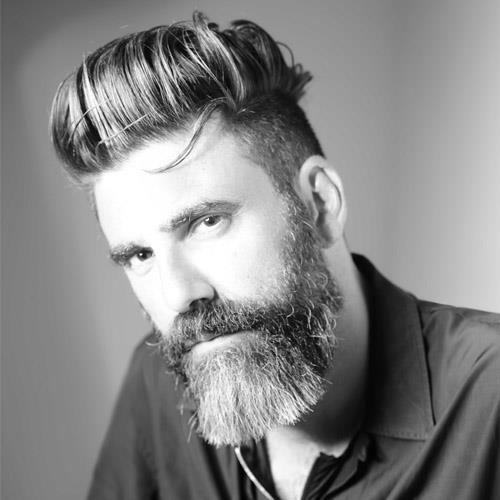
Gaby Charbachy
Founder
Label - Gaby Charbachy
The way I live my life is the source of my inspiration
Gaby Charbachy’s designs are crafted for modern, fashion-oriented women who enjoy stepping outside the traditional limits. Characterised by technically challenging cuts and attention to detail, his dresses are daring yet feminine. Well-known for his red-carpet creations, the Lebanese designer’s pieces have been worn by celebrities like Tong Liya, Ann Andress and Sonakshi Sinha. In a chat with Fibre2Fashion, Charbachy talks about his journey, inspirations, and his future plans for the label.
Fibre2Fashion: How did you foray into the fashion industry?
Gaby Charbachy:
I started out by working in our traditional family business; my father was a costume designer who worked on formal costumes. I was young and very passionate. However, during my senior high school years my parents advised me to complete my education and get a degree, so that I had something to fall back on in case things didn’t work out. Things were uncertain in Lebanon at that time because of the war. I had good grades in school and opted for a bachelor’s degree in engineering architecture.
F2F: How would you define the style and vibe of your collections?
GC:
I like to work a lot on the structure of the dress. I like my designs to be feminine in a way. You always see an A1 feminine aspect in any dress that I make—be it the emphasis on the waistline or on the bust or sometimes on both. I also like to do a lot of fabric manipulation. By tweaking it or splitting it, we can create structural volumes that help in giving each outfit its unique style.
F2F: What inspires you to work on such eclectic and glamorous collections? Is there any particular fashion, style, or mood board that you follow?
GC:
I feel that the way I live my life is the source of my inspiration. I mean, when it comes to me, it’s not like a button that I can switch on and off. You cannot just come to work at 8 a.m. and turn on the inspiration button. That’s just not how it works. It is important for me to live a rich life, culturally. By exposing myself to different cultures via travelling or indulging in different experiences, I get inspired in the most unexpected ways. Having culturally rich life experiences not only inspire me but also impact my character.
F2F: How do you bring innovation in your collections?
GC:
Undoubtedly, innovation is difficult. Especially in the style that I do. If you notice, we work mainly with plain fabrics and don’t do a lot of embroidery work. It’s quite a challenge to create and recreate ideas and designs. We are always up to date with the latest innovations and technologies in fabric. When we began working with metallic fabric, nobody really knew how to work with it even from a technical point of view. How does one sew on such fabric? I love experimenting and venturing towards different concepts.
F2F: Isn’t it challenging to come up with new designs and silhouettes frequently?
GC:
Yes, it is a bit difficult sometimes, especially when you think of the sales part since we are represented in about 70 points of sale and maybe 30-35 countries. So, it’s quite a challenge to create something that will resonate with or be appreciated by people from different cultures, having different body shapes and various skin tones. For instance, the colour red could be well received in one country. However, in another country it is not worn because of certain cultural or traditional beliefs. So, we have to carefully study our market, which we do, and we have to be somewhat flexible as well with the differences of countries we sell to.
F2F: Which artist or celebrity would you love to see in your collections?
GC:
I’d love to see Hollywood actress Uma Thurman sporting my label.
F2F: With so many couture-based brands in the market, what makes your label stand out?
GC:
From the beginning, we have been focusing on cuts and fits that flatter a traditionally feminine figure. Plus, I think that what I do with structured elements is quite unique. Most cultural brands rely heavily on embroidery, whereas we work keeping in mind the figure of the client or focus on the design itself.
F2F: Please share some insights on the Lebanese and the Middle Eastern fashion industry.
GC:
Lebanon is a very old country. We are the centre or the hub of different art forms, not just fashion. Also, we are strategically located between the East and the West and have been exposed to different fashions and cultures. Most Lebanese people speak three languages, which makes us a very open and welcoming society.
F2F: Please advise on how to elegantly wear a bespoke garment or dress.
GC:
For me, the most important thing is that a lady should feel comfortable in what she’s wearing. Even if you own the most gorgeous dress in the world, you won’t be able to pull it off if you are not comfortable wearing it. Discomfort makes the wearer of an outfit radiate negative energy. So, it is important to really like what you’re wearing because that directly impacts your confidence. After that, it is important to know what message you want to send across based on what you’re wearing and how you’re looking.
F2F: Do you have any tips for the modern woman on slaying a basic day in style?
GC:
I think the number one important thing is to be comfortable with who you are at the end of the day. I believe that one can be ‘playful’ more in the day than at night, so you can always use accessories that are a bit flashier at that time. I also suggest mixing and matching different designs and different concepts depending on your mood.
F2F: What, according to you, will be the top five fashion trends for 2023?
GC:
I’ll talk about colours first. When we presented our collection in Paris during the Fashion Week, we worked a lot on flashy colours like fuchsia, which is really in trend right now. We are working with orange and lime as our main colours. We also branched off a little bit to some pink and black.
F2F: Any advice you’d like to share with young aspiring designers?
GC:
Work hard, that’s it. I advise learning different skills in addition to just design because doing so gives you a well-rounded view of things. You cannot be just a designer that nobody sees. Good social skills are important for building a cordial relationship with clients. I do understand that being a designer can make one immersed in work most of the time. However, it is critical that you strive towards acquiring different skills as well.
F2F: What are your future goals for the label? Where do you see yourself in the next five years?
GC:
We had our couture line a year before COVID and had launched the ready-to-wear segment but that didn’t really take off because of the pandemic. We were not at fashion shows until recently, so we want to focus on that because there’s a big demand for more ready-to-wear clothes. We were also expanding both in India and China. However, our plans were halted by COVID, especially in China. In India, we are facing logistical issues because of imports. Although things have become a little bit difficult, we’re working towards solutions.

Rahul Mehta
Anurag Batra
Fanny Vermandel
Aseem Prakash
Gabi Seligsohn
Arun Sirdeshmukh
Bill D’Arienzo
Abhay Gupta
Rahul Mehta
Pradip Mehta



_8.JPG)









